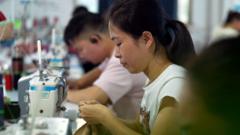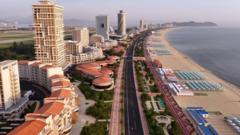This article examines the working conditions in Guangzhou's Panyu district, where workers endure long hours to produce affordable clothing for global markets, raising questions about labor rights and corporate responsibility.
**Unveiling the Reality of Fast Fashion: Shein's Supply Chain in China**

**Unveiling the Reality of Fast Fashion: Shein's Supply Chain in China**
An in-depth exploration of the labor conditions behind Shein's rapid rise in the fast fashion industry.
In Guangzhou's Panyu neighborhood, known as the "Shein village," a network of factories is buzzing with activity to meet the demand of the world's largest fast fashion retailer, Shein. The sound of sewing machines fills the air as workers produce clothing destined for over 150 countries. Many workers report grueling schedules, often clocking in up to 75 hours a week, significantly over the legal limit imposed by Chinese labor law. Despite this high workload, many only receive one day off a month, revealing issues of labor exploitation amid Shein's booming success.
The rapid ascent of Shein, valued at an astonishing £54 billion after just five years, has been accompanied by scrutiny regarding its labor practices. The company faces allegations of underpaying workers and utilizing the practices of forced labor in some of its supply chain locations, including a recent incident involving child labor. Shein stated it is committed to the fair treatment of its workforce, claiming to invest significantly in compliance and governance, yet these statements come as the company prepares for a potential public offering in London.
Factory owners in Panyu confirm that minimum wages are far lower than what is deemed necessary for a living wage, and some workers earn as little as two yuan for each item stitched. This precarious economic situation forces workers into harrowing work hours to make ends meet, often sacrificing their health and personal lives. "We earn so little. The cost of living is now so high," lamented a worker from Jiangxi who is trying to support her children back home. The labor markets of Panyu reflect this struggle, bustling with workers seeking temporary jobs in a competitive and demanding environment.
The tension between Shein's production demands and labor rights is echoed by rights organizations, which describe the situation as exploitative. Reports have highlighted the lack of basic adherences to Chinese labor laws, including mandated rest days. As criticism mounts from various quarters, including U.S. lawmakers associating the brand with unethical labor practices, Shein's insistence on compliance and improved conditions comes under increased scrutiny.
Even though Shein has relocated its headquarters to Singapore, much of its supply chain remains rooted in China. The integrity of its operations is increasingly being questioned, especially concerning sourcing materials from regions like Xinjiang, which is associated with allegations of forced labor. Experts argue that for Shein to maintain confidence among investors and consumers, it must enhance transparency and take steps towards ethical sourcing and production.
While some factory owners acknowledge the financial burdens imposed by Shein's business model, others see it as an opportunity that sustains jobs and income. As the lights of the factories stay on well into the night, workers remain determined to meet production quotas while hoping for better conditions in the industry's future. The dichotomy of pride in their contributions to global fashion clashing with personal struggles characterizes the reality for many in these factories, as they navigate the complexities of modern-day labor within the fast fashion landscape.
The rapid ascent of Shein, valued at an astonishing £54 billion after just five years, has been accompanied by scrutiny regarding its labor practices. The company faces allegations of underpaying workers and utilizing the practices of forced labor in some of its supply chain locations, including a recent incident involving child labor. Shein stated it is committed to the fair treatment of its workforce, claiming to invest significantly in compliance and governance, yet these statements come as the company prepares for a potential public offering in London.
Factory owners in Panyu confirm that minimum wages are far lower than what is deemed necessary for a living wage, and some workers earn as little as two yuan for each item stitched. This precarious economic situation forces workers into harrowing work hours to make ends meet, often sacrificing their health and personal lives. "We earn so little. The cost of living is now so high," lamented a worker from Jiangxi who is trying to support her children back home. The labor markets of Panyu reflect this struggle, bustling with workers seeking temporary jobs in a competitive and demanding environment.
The tension between Shein's production demands and labor rights is echoed by rights organizations, which describe the situation as exploitative. Reports have highlighted the lack of basic adherences to Chinese labor laws, including mandated rest days. As criticism mounts from various quarters, including U.S. lawmakers associating the brand with unethical labor practices, Shein's insistence on compliance and improved conditions comes under increased scrutiny.
Even though Shein has relocated its headquarters to Singapore, much of its supply chain remains rooted in China. The integrity of its operations is increasingly being questioned, especially concerning sourcing materials from regions like Xinjiang, which is associated with allegations of forced labor. Experts argue that for Shein to maintain confidence among investors and consumers, it must enhance transparency and take steps towards ethical sourcing and production.
While some factory owners acknowledge the financial burdens imposed by Shein's business model, others see it as an opportunity that sustains jobs and income. As the lights of the factories stay on well into the night, workers remain determined to meet production quotas while hoping for better conditions in the industry's future. The dichotomy of pride in their contributions to global fashion clashing with personal struggles characterizes the reality for many in these factories, as they navigate the complexities of modern-day labor within the fast fashion landscape.




















